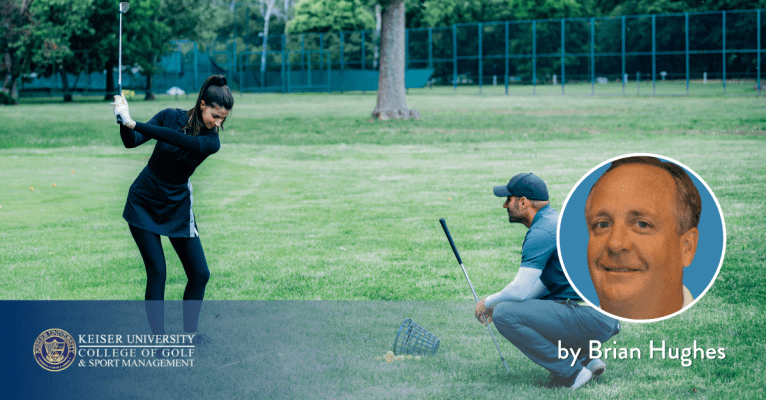Advanced Techniques for Coaching Elite Golfers

By Brian Hughe, Keiser University College of Golf Program Director and PGA Master Professional
Advanced Techniques for Coaching Elite Golfers
Through hard work, frequent practice, regular play, and an overall dedication to improvement, your game has steadily improved over the years. However, it seems like getting over that last hurdle and scoring lower consistently continues to elude all but the most accomplished of players. As we continue to evolve as players, improvement is usually in very small steps, many of which are almost unrecognizable to the eye, but taken in total, can bring that scoring average down to a level where competing in high-stakes events can be a reality.
Coaching and Instructing Elite Golfers
When taking the next step to becoming “elite,” there must be a much more systematic approach for coaches and players to take for improvement. In the early stages of learning golf, most improvement comes in the form of technique development – in other words, golf swing work. While developing a sound golf swing is an admirable goal, there needs to come a point where work in this area adjusts from learning body and club movement to applying the technique and trusting the motion. However, it is a common fault for golfers not to evolve from this way of thinking, leading them down a path of constant technique adjustment. The evolution of improvement needs to come from other sources once the technique becomes consistent and reliable.
Data Analysis
So, if not in technique improvement, how does the golfer improve? The process should start with a statistical analysis of where elusive shots and half shots may be lost on the course. Without data analysis, work done in practice may be misdirected towards areas that are perceived to be issues, but in actual practice may not be the biggest areas of concern.
Golfer data analysis involves collecting and interpreting a wide range of performance metrics to identify strengths, weaknesses, and trends in a player’s game. This data typically includes statistics such as fairways hit, greens in regulation, putting average, driving distance, and strokes gained in various areas (off the tee, approach, around the green, and putting). By leveraging tools like launch monitors, GPS shot tracking, and performance apps, players and coaches can gain a detailed understanding of what areas need attention. For example, if a golfer consistently loses strokes on approach shots from 150–175 yards, targeted practice in that range can be introduced to improve scoring efficiency.
The key to effective golfer data analysis lies in turning raw numbers into actionable insights. Rather than practicing generically, players can use the data to structure practice sessions with clear objectives, such as improving short game consistency or increasing accuracy off the tee. Over time, tracking improvements in specific metrics helps ensure that training efforts are yielding results. For competitive golfers, data analysis also aids in strategic decision-making on the course, such as selecting the right club based on tendencies or adjusting course management strategies. In essence, data-driven feedback bridges the gap between subjective feelings and measurable performance, offering a roadmap for continuous improvement.
Impact and Low Point Control
After analysis of facts (i.e., what is happening to the golf ball compared to the desired flight), impact factors need to be a focus. Chief among these factors is recognizing and prioritizing where the low point of the golf swing occurs. This is a critical concept that often separates consistent ball strikers from those who struggle with contact. It refers to the lowest point in the arc of your club’s path during the swing. For irons and wedges, the ideal low point is slightly ahead of the golf ball, meaning the club strikes the ball first and then the ground. With the ball on a tee (driver), the low point should be before ball contact to help launch the shot at the ideal trajectory. Golfers of any level who make low-point errors will struggle with consistent contact and trajectory, with the result being fat or thin shots.
To improve your low point control, ball position at address is a key, ideally matching the club selection, desired ball flight, and relationship to body movement and weight transfer during the swing. A proper shift of weight onto your lead foot during the downswing, combined with a forward-leaning shaft at impact, helps move the low point ahead of the ball. Practicing with alignment sticks or drawing a line on the ground to simulate the ball position can give instant feedback—if your divot starts after the line, you’re doing it right. Mastering the low point doesn’t just lead to better strikes; it brings more predictability to your game, which is key to lower scores.
Clubface Orientation: Maximizing Control
Clubface control and orientation are essential components of a golfer’s ability to consistently strike the ball with accuracy and precision. The orientation of the clubface at impact largely determines the direction and curvature of the shot. If the clubface is square to the path the club is traveling on, the ball will tend to fly straight. However, slight variations, such as an open or closed face relative to the club path, will cause curvature in the shot (slices or hooks). Mastering clubface control requires both technical understanding and application of the laws of ball flight, along with the physical consistency to move the club as desired. Small deviations in grip, hand position, or wrist angles can drastically affect ball flight, and as such, should match what the player’s intentions are for the shot.
To effectively manage the clubface, the player needs to first focus on their setup at address. Developing pre-swing principles, such as functional grip and alignment, sets the stage for how the clubface will return to the ball. Once these basics are set in place, the golfer can focus on clubface alignment during the swing by maintaining awareness of how wrist and forearm movements influence the face angle. During the downswing and through impact, rotational control of the clubface is critical. Highly skilled golfers develop the ability to manipulate face angle intentionally, allowing them to shape shots on demand. With the use of drills that focus on face awareness, such as impact bag work or slow-motion swings, the player can improve their control of the clubface.
Club Selection and Shot Type Decision Making
To maximize the physical skill set that they have developed, a competitive golfer now needs to work on decision-making skills. Making good golf decisions on club selection starts with an understanding of your distances and being honest about your strengths and weaknesses. Before every shot, an assessment of the distance to the target, elevation changes, wind conditions, and a myriad of other things needs to be completed. It’s important to choose a club that gives you the best chance to reach your intended landing area, not just the green. Many golfers make the mistake of always choosing the club that reaches the flag in perfect conditions, rather than accounting for imperfect contact or environmental factors. This is where a realistic understanding of how well the player is playing and their confidence with their decision really can pay dividends, as a smart choice means taking the club that yields the most predictable results, especially under pressure.
Equally important is choosing the right shot type for the situation. Consider the lie, the slope, and how much green you have to work with. For example, a high flop shot may look impressive, but it’s often riskier than a lower bump-and-run that rolls out more predictably. Wind direction and green firmness also affect shot choice—punch shots, draws, fades, or even layups all have their place depending on the circumstances. Good decision-making in golf means playing the percentages, staying within your skill set, and prioritizing consistency over heroics.
Fitness and Muscle Training
The golfer also needs to consider the one piece of equipment they can’t replace – their bodies. Fitness and muscle training play a crucial role in enhancing golf performance by improving strength, stability, and endurance. Golf may appear to be a low-intensity sport, but it demands a combination of core strength, flexibility, and precise muscle control to generate powerful and consistent swings. A well-rounded fitness program for golfers typically includes cardiovascular conditioning, mobility exercises, and strength training focused on the core, hips, and shoulders. These elements help players maintain posture, reduce injury risk, and sustain energy levels throughout a round.
Muscle training specifically targets the development of functional strength that translates directly to the golf swing. Exercises such as rotational core movements, resistance band work, and compound lifts (like squats and deadlifts) improve both power and control. By building strength in key muscle groups—particularly the glutes, hamstrings, obliques, and upper back—golfers can increase swing speed, improve accuracy, and gain consistency. Additionally, tailored training regimens can correct muscular imbalances, enhancing overall movement efficiency and helping golfers perform at their peak while avoiding common overuse injuries.
Conclusion
Any assessment of elite-level performers has to assume that they are incredibly skillful in all areas. The college golfer brings youth, strength, flexibility, and in today’s game, the ever-important aspect of club speed. The professional-level player takes these traits and builds upon them, adding a mental component of confidence and experience in high-pressure environments to the exuberance of youth. With this in mind, coaching these golfers involves little technical instruction but much more concentration on how to train these skills and get them as pressure-proof as possible. Getting the most out of the player, taking advantage of their desire and dedication to the craft, becomes the true skill needed in coaching these high-level performers.














